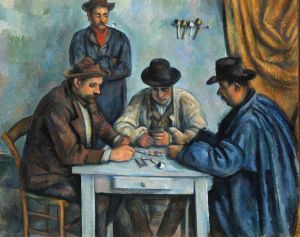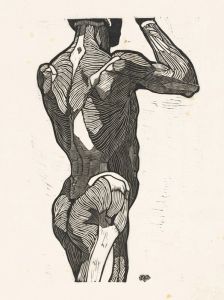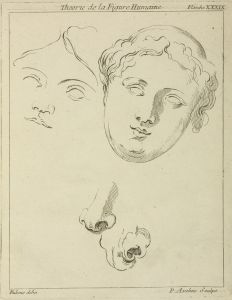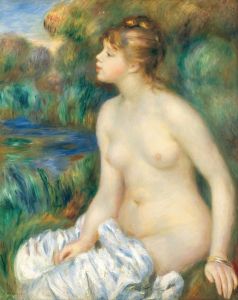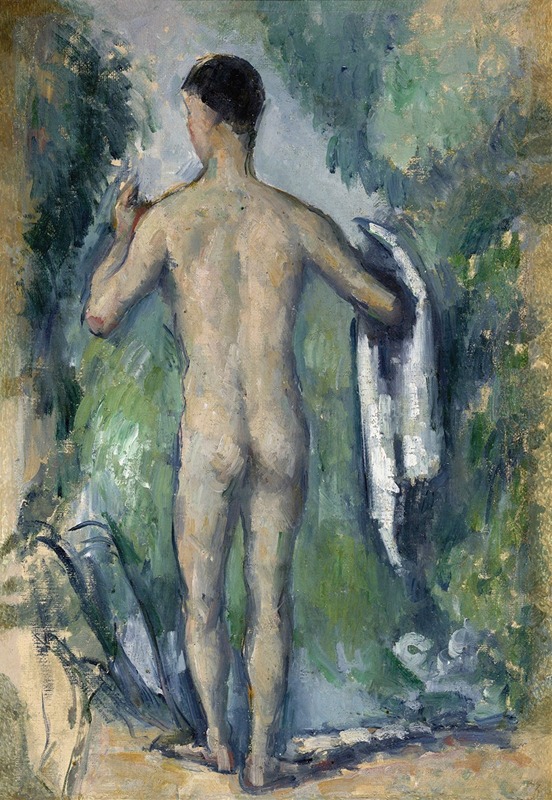
Standing Bather, Seen from the Back
A hand-painted replica of Paul Cézanne’s masterpiece Standing Bather, Seen from the Back, meticulously crafted by professional artists to capture the true essence of the original. Each piece is created with museum-quality canvas and rare mineral pigments, carefully painted by experienced artists with delicate brushstrokes and rich, layered colors to perfectly recreate the texture of the original artwork. Unlike machine-printed reproductions, this hand-painted version brings the painting to life, infused with the artist’s emotions and skill in every stroke. Whether for personal collection or home decoration, it instantly elevates the artistic atmosphere of any space.
Paul Cézanne's "Standing Bather, Seen from the Back" is an intriguing work that exemplifies the artist's innovative approach to form and composition. Painted in the late 19th century, this piece is part of Cézanne's broader exploration of the human figure, a subject he revisited throughout his career. Cézanne, a pivotal figure in the transition from 19th-century Impressionism to 20th-century Cubism, is renowned for his unique method of building form with color and his analytical approach to nature.
"Standing Bather, Seen from the Back" depicts a nude female figure from behind, a perspective that allows Cézanne to focus on the contours and volume of the human body. This perspective is significant as it emphasizes the structural aspects of the figure rather than the identity or facial expression, which aligns with Cézanne's interest in form over narrative. The painting is characterized by its use of subtle color gradations and brushwork that suggest the solidity and weight of the figure, a technique that was innovative for its time.
Cézanne's treatment of the bather reflects his departure from the traditional representation of the human body. Instead of idealizing the figure, he presents it in a way that is both realistic and abstract, capturing the essence of the form without adhering to the conventions of anatomical accuracy. This approach can be seen as a precursor to the modernist movements that followed, influencing artists such as Pablo Picasso and Henri Matisse.
The background of the painting is typically Cézannesque, with a landscape that is suggested rather than detailed. This serves to place the figure within a context that is both natural and timeless, yet it does not detract from the central focus on the bather. The interplay between the figure and the background demonstrates Cézanne's mastery in balancing different elements within a composition.
Cézanne's bathers are often interpreted as a reflection of his personal artistic journey. They represent his quest to understand and depict the underlying structure of the natural world. In "Standing Bather, Seen from the Back," this quest is evident in the way the figure is constructed through a series of planes and facets, a technique that would later be expanded upon by Cubist artists.
The painting also reflects Cézanne's interest in the classical tradition, yet it simultaneously breaks away from it. While the subject of the bather has roots in classical art, Cézanne's interpretation is distinctly modern, characterized by a departure from idealized beauty and a focus on the geometric aspects of the human form.
"Standing Bather, Seen from the Back" is a testament to Cézanne's role as a bridge between the past and the future of art. His innovative techniques and perspectives challenged the artistic norms of his time and laid the groundwork for future developments in modern art. The painting remains a significant work in Cézanne's oeuvre, illustrating his profound impact on the evolution of artistic expression.






